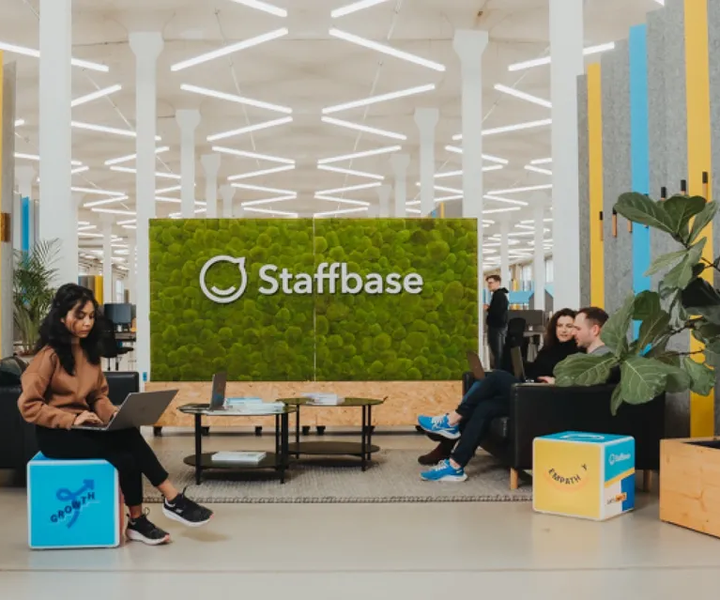How the AI Intranet Is Revolutionizing Internal Communication
AI-native intranets are transforming employee engagement, streamlining workflows, and delivering truly personalized communication that reaches every employee — wherever they work — keeping teams connected and productive like never before.

AI-native intranets are redefining how organizations connect and communicate. They’re not just layering smart features onto legacy systems; they’re built from the ground up with intelligence at their core — transforming content management, knowledge sharing, and the employee experience itself.
By integrating advanced technologies such as machine learning, natural language processing (NLP), and data analytics, modern intranets like Staffbase’s AI-native Employee Experience Platform deliver personalized, predictive, and secure experiences that cut through content noise, streamline operations, and drive measurable impact — reshaping what an intranet can be in the age of AI.
6 key features of AI-powered intranets
1. Personalization
AI-driven personalization transforms the intranet into a truly individualized experience for every employee — not by adding a layer of intelligence on top, but by building it into the core. It tailors content based on roles, preferences, and behaviors, anticipating needs before they’re expressed and surfacing the most relevant information at exactly the right moment.
By analyzing how employees interact with the intranet — what they search for, read, and engage with — AI ensures that each individual receives highly relevant news, updates, and resources. It also learns from context, priorities, and patterns of work, offering proactive suggestions rather than passive recommendations. This customization goes beyond just delivering the right content; it intelligently determines the best timing, channel, and format — whether it’s a mobile push, app notification, or email digest — ensuring maximum engagement and relevance across the organization.
For example, frontline workers might receive quick updates or mobile notifications that align with their on-the-go work style, while office-based employees may get more detailed reports or articles that fit their daily routines. Because Employee AI spans intranet, app, email, and signage, it automatically matches each message to the employee’s preferred channel and device. AI also takes into account personal preferences, such as language, communication styles, or frequency of updates, further enhancing the user experience. By filtering out irrelevant information, AI prevents content overload, ensuring employees focus only on what matters most to their work, creating clarity instead of noise and delivering the confidence that nothing important gets missed.
This personalized approach not only improves efficiency but also boosts employee satisfaction by making the intranet a tool that truly serves their individual needs. It turns a static channel into an adaptive companion — one that learns, predicts, and communicates with each person in the way that works best for them — supporting both productivity and engagement at scale.

2. Advanced search capabilities
AI-native intranets elevate search into a true conversation. Using natural language processing (NLP) and semantic understanding, employees can now search in plain language — or simply ask a question — instead of relying on rigid keywords or filters. This makes finding the right information easier and faster, as the system understands the context and intent behind each query — delivering not just links, but precise answers and actions. Whether an employee is looking for a document, policy, or update, the intranet’s AI companion can surface summaries, related content, or next steps, predicting what they’re likely to need next and refining results accordingly.
One of the most powerful aspects of AI-enhanced search is federated and secure search, which enables users to access multiple data sources at once while respecting access permissions and data-protection policies — providing a unified, cross-platform experience employees can trust. Instead of searching individual databases or systems separately, employees can retrieve information from a wide range of internal sources — such as emails, knowledge bases, document libraries, or external platforms — through a single intelligent interface.
This capability extends across channels, connecting the intranet with the broader digital workplace, from Staffbase Email to the Employee App. This reduces the time spent switching between systems and ensures employees can quickly access the information they need — wherever they are and however they ask for it — fueling faster decisions, smoother collaboration, and fewer communication dead ends.
By aggregating information across diverse systems, AI improves both the accuracy and speed of search results, enabling better productivity and more informed decision-making. It even surfaces insights that might otherwise stay buried — connecting knowledge, context, and people across teams — so employees spend less time hunting and more time doing.
3. Automated content management
AI is redefining content management within intranets by automating and streamlining every step of the process — from content creation to distribution — and empowering communicators with intelligent writing companions that enhance, not replace, human creativity. With intelligent automation, AI can suggest the best times to publish content, ensuring that messages reach employees when they are most likely to engage. It analyzes audience behavior and channel performance — from intranet to email to app — to recommend the optimal time, tone, and channel for each message. It also identifies the most relevant audiences based on roles, behavior, or department, ensuring that each piece of content is targeted effectively and delivered where it will have the greatest impact, reducing the chance of irrelevant information cluttering employee feeds.
One of the most valuable aspects of AI in content management is its ability to generate and refine content intelligently — from summarizing lengthy documents into concise, digestible formats to drafting or translating updates automatically. Employees can quickly access key takeaways from reports or announcements, saving time and increasing productivity. Whether it’s summarizing meeting notes or condensing company-wide updates, AI ensures content remains clear, inclusive, and consistent in voice — no matter the language or channel — making critical information more accessible without sacrificing accuracy.
AI also ensures that the intranet remains a fresh and reliable source of information by proactively managing content lifecycles — automatically flagging outdated pages, prompting reviews, and archiving materials when necessary — so communicators can focus on strategy rather than maintenance. This reduces the manual labor traditionally required to keep content up to date, improving overall accuracy and relevance across the platform. As a result, employees can trust that the information they find is timely, accurate, and approved within clear governance boundaries — strengthening confidence in the intranet as a single source of truth. This continuous, hands-off content management approach enables organizations to maintain a dynamic, up-to-date intranet with minimal effort — a living system that adapts, learns, and supports communicators every day.
4. Virtual assistants and chatbots
AI-native virtual assistants and chatbots, seamlessly embedded within the intranet experience, give employees instant, intelligent support that makes daily work smoother and more efficient. These tools act as personal guides, helping employees navigate the intranet, locate information, and complete routine tasks such as scheduling meetings, submitting requests, or accessing frequently used documents. Because they’re connected across channels — from the intranet to the employee app — they meet people wherever they work, offering one consistent conversation instead of a maze of systems. By using natural language processing (NLP) and contextual understanding, chatbots can interpret intent and respond in conversational language —not just answering questions, but taking action — like pulling a report, starting a workflow, or notifying a manager — making every interaction feel natural and productive.
Beyond basic tasks, virtual assistants can now handle more complex functions — guiding new employees through onboarding, assisting with paperwork, or walking them step-by-step through company tools. They learn from organizational knowledge while staying within strict governance rules, ensuring accuracy and data security. This instant support reduces the workload on HR, IT, and other support teams by automating repetitive inquiries and freeing up people to focus on strategic, high-impact work. Whether it’s answering common questions about company policies, troubleshooting minor tech issues, or providing updates on personal leave balances, these AI copilots streamline internal processes, improve response times, and enhance the overall employee experience — 24 hours a day, across every time zone.
By offering round-the-clock availability, these tools ensure employees can access help whenever they need it — a major advantage for global, hybrid, and frontline teams. This level of automation boosts productivity, reduces operational bottlenecks, and ensures employees can quickly resolve issues without delays. Because Employee AI operates within secure enterprise boundaries, employees get real answers — not risks — every time they ask for help.

5. Security and compliance
AI takes intranet security and compliance to a new level of reliability and transparency. By continuously monitoring activity and detecting unusual behavior, it can flag potential risks in real time — helping prevent data breaches before they occur and ensuring that sensitive information remains protected across the organization.
With the ability to analyze vast amounts of activity data, AI identifies patterns or anomalies that could indicate malicious intent or internal vulnerabilities. This proactive approach enables security teams to respond faster and with greater precision, reducing risk while maintaining employee trust.
AI also automates critical security tasks such as managing user permissions and access control. By dynamically adjusting access based on role changes, user behavior, or policy updates, it ensures that only authorized people can view or edit sensitive information. This automation minimizes human error and strengthens protection without adding administrative complexity.
On the compliance side, AI helps organizations stay aligned with internal policies and external regulations. It can automatically audit content, flag potential policy violations, and track adherence across every channel. Whether ensuring data privacy compliance or meeting sector-specific standards, AI supports a robust, secure intranet environment that adapts to changing requirements — reducing the burden on IT and legal teams while safeguarding company and employee data.

6. Data-driven insights
AI-powered intranets turn employee engagement data into meaningful insight. By analyzing employee interactions and behaviors in real-time — from views and clicks to comments, reactions, and shares — AI identifies what resonates, what falls flat, and which channels are driving the greatest impact. These insights go far beyond surface-level metrics, helping communicators understand how information flows through the organization and how effectively it connects people to purpose.
These insights can go well beyond simple engagement metrics. Instead of relying on guesswork, communicators can see clear patterns: which stories inspire engagement, which topics build alignment, and where communication gaps might exist. AI can even predict how different employee groups are likely to respond to upcoming campaigns or announcements, allowing messages to be refined before they’re sent.
Today’s Employee AI takes this further by linking engagement data with organizational goals. It highlights the moments and narratives that truly shift understanding and sentiment — giving leaders a live view of communication health across every region, department, and channel.
With these real-time, actionable insights, organizations can make data-backed decisions that continuously improve relevance, inclusivity, and impact. The result is smarter strategy, stronger alignment, and a more connected workforce — proof that when communication meets intelligence, every message matters more.
 The Staffbase Smart Impact dashboard provides insights that go well beyond simple engagement metrics.
The Staffbase Smart Impact dashboard provides insights that go well beyond simple engagement metrics.
4 benefits of AI-powered intranets
1. Clarity over chaos
AI-native personalization cuts through the noise. Instead of flooding employees with generic messages, it curates a focused feed of content tailored to their roles, interests, and behaviors. By analyzing interaction patterns and work habits, the intranet surfaces only what matters most — ensuring critical updates reach the right people at the right moment.
This creates clarity instead of overload. Employees get the context they need without the clutter, so communication feels effortless, relevant, and human.
2. Smarter productivity
Intelligent search and automated content management save time at every turn. Employees can find information instantly using natural language — or simply ask a question — while AI gathers results across email, intranet, and document libraries into a single, secure view.
Behind the scenes, AI keeps content fresh and targeted. It recommends updates, archives outdated material, and suggests optimal publish times and channels. The result is a workspace that stays organized on its own — freeing communicators and employees alike to focus on the work that drives real outcomes.
3. Engaged employees, informed leaders
AI-powered intranet analytics reveal what truly connects with people. By tracking how employees engage with messages across channels, communicators can see which stories resonate and where understanding drops off. Leaders gain visibility into communication health — knowing not just what was sent, but what was seen, understood, and acted upon.
With this feedback loop, organizations can adapt in real time, refining strategies to build stronger alignment and a deeper sense of connection across teams.
4. Streamlined knowledge flow
AI transforms knowledge-sharing from a scavenger hunt into a smooth, guided experience. It connects information across silos, suggests relevant content and resources, and recommends experts or materials based on role, skill, and context.
Whether employees are on the factory floor, in the office, or working remotely, they can quickly find the insights they need without wasting time searching. This seamless flow of information fuels confidence, collaboration, and a culture of shared understanding.
A real-world example: The AI intranet in action
A clear example of the AI-native intranet in action is Staffbase Employee AI — the intelligent layer woven throughout the Staffbase platform. Built on trusted enterprise infrastructure and powered by the latest generation of large language models, it delivers both performance and peace of mind. Data stays encrypted, never used for model training, and is managed according to stringent standards such as GDPR and ISO 27001 compliance.
Employee AI goes far beyond traditional assistants. It supports communicators directly with intelligent writing tools that craft summaries, optimize structure, and generate on-brand headlines in seconds. It analyzes engagement across channels, offering insights into what messages truly connect — and where understanding might fall short.
The same intelligence powers a personalized employee experience across every touchpoint — intranet, email, app, and beyond. It delivers relevant content automatically, anticipates information needs, and provides conversational access to company knowledge.
By automating repetitive work, protecting sensitive data, and surfacing real-time insights, Employee AI turns the Staffbase intranet into a proactive partner for communicators and employees alike — one that continuously learns, improves, and delivers measurable impact across the organization.
The future of work: Powered by AI-native intranets
In today’s rapidly changing workplace, AI-native intranets are redefining how organizations communicate, collaborate, and connect. By enhancing personalization, automating routine tasks, and providing real-time, data-driven insights, they make internal communication not just faster — but smarter and more impactful.
Understanding how to build an intranet that leverages trusted, enterprise-ready AI helps businesses optimize communication, strengthen alignment, and better support their teams. Exploring modern intranet examples shows what’s possible when intelligence is built in from the start — transforming the intranet from a static channel into a dynamic, learning system that grows with your organization.
As AI continues to evolve, companies that embrace it will create more connected, confident, and empowered workforces. The future of work belongs to intranets that think with you, adapt to your people, and bring clarity to every message.










